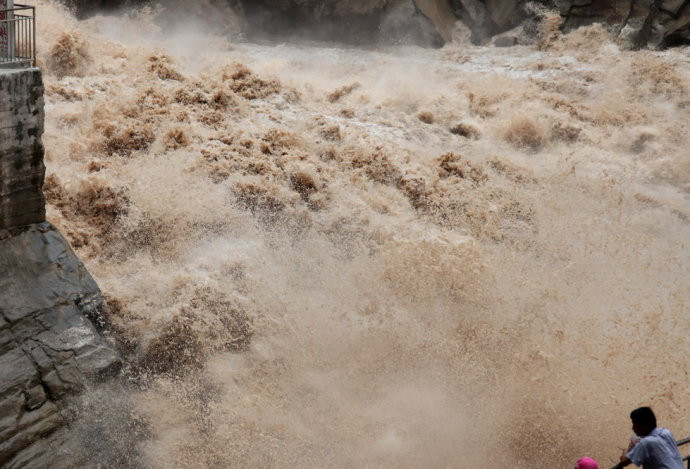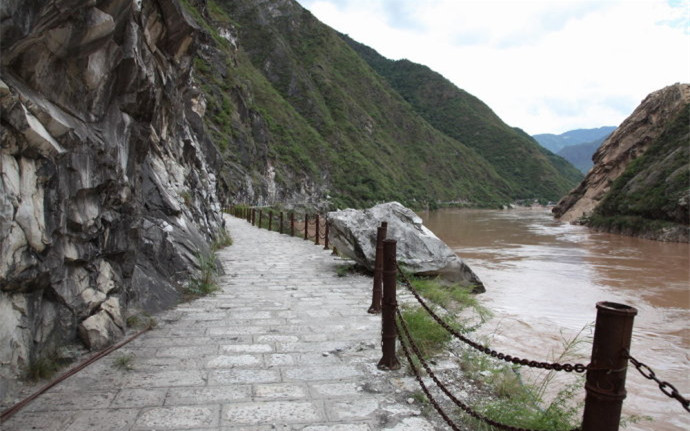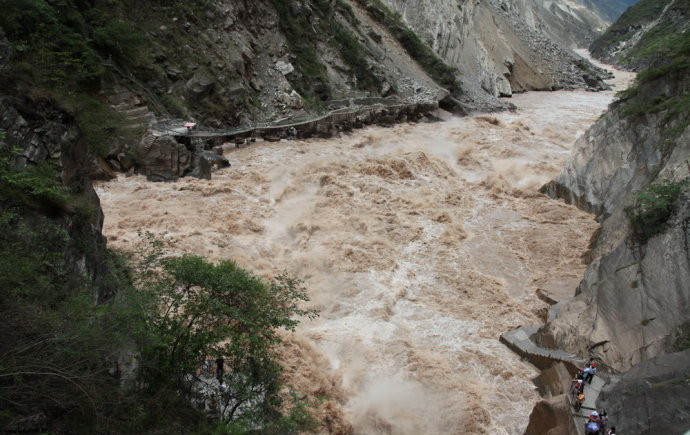
Tiger Leaping Gorge under Threat
One of the world's most spectacular natural attractions is threatened by a plan to build eight big dams on the Jinsha River (as the upper Yangtze is known), and the Chinese press and environmental groups are speaking out. The following has been summarized from articles that appeared in South Weekend (Nanfang zhoumo, Sept. 29), New Beijing News (Xin jingbao, Sept. 27) and China Youth Daily (Zhongguo qingnian bao, Sept. 26).

Here, about 1,500 kilometres upstream of the Three Gorges dam, the Jinsha River (as the upper Yangtze is known), has forced its way through two high mountains to flow through a narrow 16-kilometre-long valley. Legend has it that a tiger made the leap across the gorge at its narrowest point, where it is just 30 metres wide. Elsewhere the gorge is 60 to 80 metres wide, while the mountain peaks tower more than 3,000 metres above the surface of the river.

But now, one of the world's most spectacular natural attractions is threatened by a plan to build eight big dams in a 564-kilometre section of the river stretching from Shigu town near Lijiang and the Tiger Leaping Gorge, downstream to Panzhihua in Sichuan province and the mouth of the Yalong River. Construction of the dams would affect 13 towns and townships in four Yunnan counties, flood 200,000 mu (13,300 hectares) of prime farmland and force the relocation of 100,000 people from the fertile river valley.

Liang Yongning, a professor at Kunming University of Science and Technology, says the cascade of dams is designed to be a supplementary project to the Three Gorges dam, regulating water run-off and blocking silt from the upstream river. It will also provide water for Kunming, the capital of Yunnan.
"The Tiger Leaping Gorge project will definitely go ahead," Prof. Liang said.
Construction work related to the scheme has already begun, even though the central government has yet to approve the feasibility study. The Guangzhou-based South Weekend weekly newspaper reported that concrete pouring has begun on the foundations of one of the eight planned dams, the Jinanqiao. An engineer working at the dam site told a reporter for the newspaper that major construction activities for large-scale hydro projects normally don't begin until after feasibility studies on geological conditions, resettlement and environmental protection have been approved, though some preparatory work is allowed. "But currently there is a severe electricty shortage nationwide," the engineer explained, "and it will be easier for us to sell the electricity in the power market if we get off to an early start."
The Lijiang authorities are also happy to see the Jinanqiao dam get under way, given that the scheme represents US$50 million a year in tax revenue once power generation begins. The city government regards the dam as its No. 1 priority since its current annual revenue is just US$25 million.
But local people are not at all keen on the dam projects. Liu Jianqiang and Cheng Gong, two reporters with South Weekend, spent three days travelling 250 kilometres in the river valley, visiting six towns and townships that would be affected by the scheme and interviewing two dozen people who would be among those forced to move. None of those interviewed expressed any willingness to be resettled. Residents felt particularly concerned that the project would flood the area's best farmland, located in the river valley, which currently supports 300,000 people.
Many of the people who stand to be affected by the projects belong to ethnic minority groups, including the Naxi, Tibetans, Bai, Yi and Miao. The flooding would deal a devastating blow to local cultures, destroying many ancient villages with their distinctive architectural styles, ancient frescoes, stone coffins and other relics.
About 40 representatives of villagers who live along the Jinsha, Nu and Mekong (or Lancang) rivers gathered in Lijiang from July 21 to 25, calling for a halt to hydropower development in the three river valleys that would inflict damage on the lives of local people and on the environment.
In July 2003, UNESCO listed the Three Parallel Rivers National Park as a world natural heritage site because of its special importance for geological research, extraordinary natural beauty, and wealth of biological and cultural diversity. United Nations officials were puzzled when Chinese authorities asked that Tiger Leaping Gorge, one of the main features of the park, be excluded from the arrangement. Why, the officials asked, was the magnificent gorge not to be included? "To allow for the construction of hydro dams," Prof. Liang Yongning told them.
Xie Ninggao, a professor at Beijing University's World Heritage Research Centre, told a South Weekend reporter: "A location that has been listed as a world heritage site must be natural and intact. Once dams are built on a river, they transform it into a man-made reservoir and damage the riverine ecosystem."
Officials at the State Environmental Protection Administration (SEPA) expressed shock about the proposed dams when a South Weekend reporter asked them about the threat to Tiger Leaping Gorge. An official in charge of environmental assessment claimed to know nothing about the plans, saying: "How is it that big dams would be permitted near Tiger Leaping Gorge? The site is one of the most dazzling and precious natural wonders in all of China. SEPA will not approve any plan to build a big dam in that area."
Dr. Nu Zhi, an environmentalist with the Chinese non-governmental organization Protection International, has argued that it is not simply a question of whether to build a particular dam at a certain spot, but a matter of how decisions on large-scale engineering projects are made. The dam could be built if it was assessed in a democratic way, and the benefits really were found to outweigh the costs. "We want a healthy decision-making process," he said.
Representatives from nine Chinese environmental NGOs met in Beijing in September and sent a letter to project authorities urging them not to proceed with the plan to dam Tiger Leaping Gorge. "We call for a halt to the project to prevent damage to the cultural and natural heritage, causing social instability and economic loss," they wrote.
At the same time, a number of scholars, environmentalists and journalists – from the Chinese Academy of Social Sciences, Qinghua University, the State Seismological Bureau, State Forestry Bureau, Xinhua News Agency and China Central Broadcasting Station – also issued a joint statement calling on policy-makers to put long-term interests ahead of short-term gain and to leave Tiger Leaping Gorge untouched, for future generations and the world.
Translated by Three Gorges Probe (Chinese) editor Mu Lan.
Related stories:
Stop the Hutiaoxia dam! , petition signed by nine Chinese NGOs, Sept. 26, 2004
Hutiao dam project demands reconsideration , China Daily, Sept. 28, 2004
Yunnan's Jumping Tiger Gorge to be submerged under reservoir , Interfax, Sept. 13, 2004
Admission Fee:¥0

You will only receive emails that you permitted upon submission and your email address will never be shared with any third parties without your express permission.
